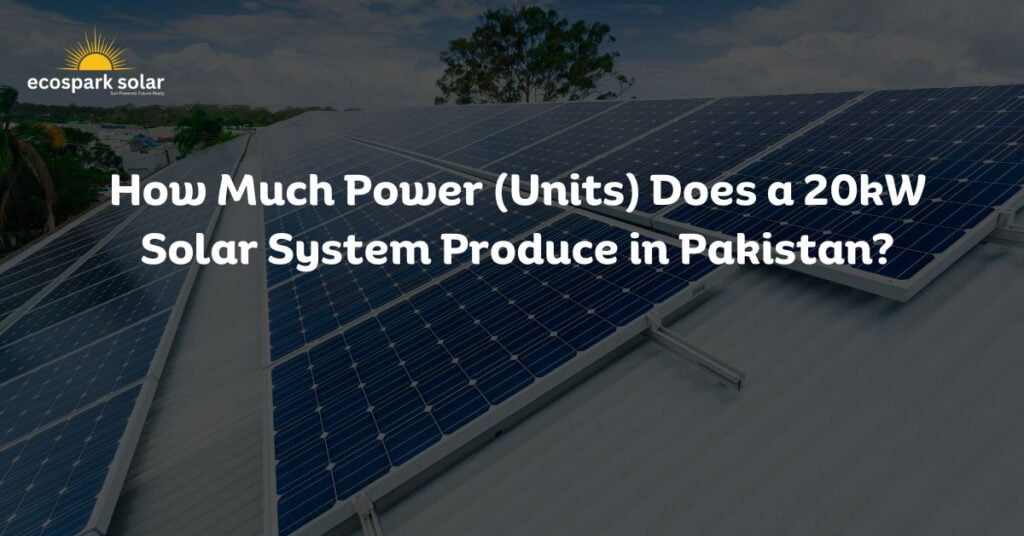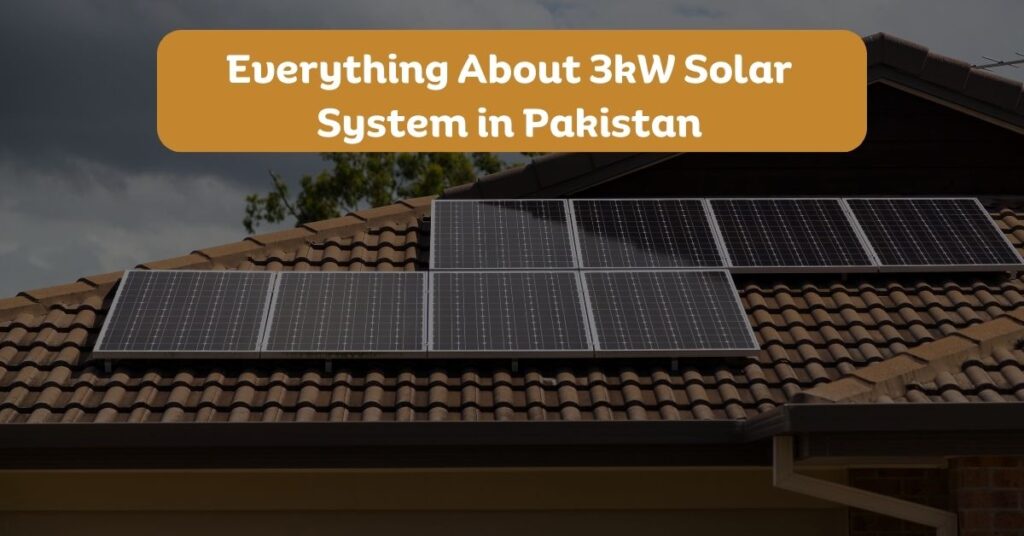20 kilo-watt (kW) systems are perhaps the largest solar systems used in residential buildings. They can also power medium-sized businesses and small-scale industrial units. When used in a home, it can power absolutely everything in a 6-bedroom house. If you want to install a 20kW system, the first question that might pop up in your mind will be: how much power does a 20kW solar system produce in Pakistan? And by power, we mean units of electricity.
That’s what we will discuss in today’s entry.
To be specific, we will discuss the following:
- How to determine the energy output of a 20kW solar system?
- How much power (units) does a 20kW solar system produce in Pakistan?
- Factors influencing the production capacity of a 20kW solar system.
- Electricity production of a 20kW solar system in various cities of Pakistan, including Islamabad, Karachi, Peshawar, Quetta, Lahore, and more.
- How to optimize the energy generation of a 20kW solar system?
Before we calculate the power output, it is important to discuss a few factors that impact the power generation capacity of solar panels.
Factors Influencing Solar Power Production of 20kW Solar Systems
The power output of a 20kW solar system depends on several factors, which can lead to varying energy production in different locations, even with similar specifications. For example, the same 20kW system can produce different power in different conditions.
Why? Let’s see!
Solar Irradiation Levels in Your Area
First and foremost, the amount of sunlight a solar system receives is the primary determinant of its power generation. In Pakistan, peak sun hours range from 4 to 7 hours per day, making it quite an ideal place for solar power generation. However, the availability of sunlight can vary based on the season and location within the country.
For example, Islamabad receives around 5.5 peak sun hours, while Skardu receives around 3.4. That means that a 20kW system installed in Islamabad would generate more power than its counterpart in Skardu.
Want to read more on this? Explore our guide to understanding peak hours in Pakistan.
The Efficiency of Solar Panels and Inverters
The efficiency of solar panels and inverters plays a significant role in determining power production. In Pakistan, the average efficiency of solar panels is approximately 18%, with newer panels offering upwards of 20% efficiency. The more efficient your solar panels are, the more sunlight would it convert into DC electricity.
Talking about DC electricity, we would need to convert it into AC electricity, for which we use inverters. We recommend high-quality inverters with above 97% efficiency to convert the generated electricity into usable electricity fully.
Solar Array Orientation and Tilt Angle
When many solar panels are combined, we call it a solar array. The orientation and tilt angle of your solar array significantly impacts the power production of your 20kW solar system. For optimal results in Pakistan, the ideal orientation for solar panels is south-facing at 180 degrees, while the tilt angle should match the latitude of the installation location, which ranges from 23 to 37 degrees.
In Islamabad, the elevation angle would be around 25-40 degrees—the lower range is for summer, and the higher range for winter. If you want optimal performance throughout the year, it would be around 30 degrees. Proper panel orientation ensures maximum exposure to sunlight throughout the day.
You can read more about it in our guide to estimating the direction and elevation angle.
A solar system for everyone.
We’re customer-centric; we will find you a solution within your budget. Whatever your project size, you can always save with Ecospark Solar.
Shading and Obstructions
Next, we have shading and obstructions. Shading from nearby structures, trees, or other obstructions can diminish the power output of solar panels. To maximize energy production, it is important to install panels in areas with minimal shading. In unavoidable shading situations, measures like using micro-inverters (if available in the market) can minimize their impact on system performance.
| You May Like to Know: How Much Does a 20kW Solar System Cost in Pakistan? |
Dust and Debris
Lastly, the accumulation of dust, debris, or bird droppings on solar panels can reduce their sunlight absorption, leading to compromised power generation. Regular cleaning and maintenance of solar panels are essential to ensure optimal performance and maximize energy generation.

Understanding the Power Production of a 20kW Solar System in Pakistan
While calculating the power output, we will keep some of the factors mentioned above in mind. Based o that, a typical 20kW solar system in Pakistan can generate between 68 and 100 kWh (units) of electricity per day, translating to approximately 2040 to 3000 units per month.
This capacity makes a 20kW solar system suitable for powering larger homes or businesses that consume around 2000 to 2500 kWh of electricity monthly. It can easily handle various appliances, including refrigerators, air conditioners, and other electrical equipment.
How Many Units Does a 20kW Solar System Produce Per Day?
To calculate the electricity generated by a solar system, the following formula is used:
| Daily production of a solar panel = Solar panel capacity x Peak sun hours x Efficiency factor |
For a 20kW solar system, assuming 5 peak sun hours and an efficiency factor of 0.8, the daily production would be:
| Daily Production of 20kW System = 20,000 watts x 5 x 0.8 = 80 kWh (units) |
The actual power generated may vary depending on factors such as location, weather conditions, and system efficiency.
For instance, in areas that receive 6 sun hours, the power produced per day would be 96 kWh (units). Similarly, the number of units generated could be slightly less in winter.
How Many Units Does a 20kW Solar System Produce Per Month?
If you want to calculate your monthly production, it is simple. Just multiply the daily production by 30, and you will get it.
| Monthly production of a 20kW solar system = Daily production x 30 = 80 x 30 = 2400 units (kWh) |
As discussed, the actual power generated on a monthly basis may vary depending on the factors mentioned above.
Power Generation of a 20kW System in Different Pakistani Cities
The power generation potential of a 20kW solar system may vary slightly across different cities in Pakistan due to variations in solar irradiation levels. Let’s take a look at the power production estimates in the major cities of Pakistan.
How Much Power Does a 20kW Solar System Produce in Islamabad?
In Islamabad/Rawalpindi, a 20kW solar system can generate an average of 78-88 kWh of electricity per day or 2500 units per month. With favorable solar conditions and the availability of net metering, Islamabad is an excellent location for solar energy adoption. Additionally, since load shedding is minimal, it makes sense to install an on-grid system.
How Much Power Does a 20kW Solar System Produce in Karachi?
In Karachi, a 20kW solar system can generate an average of 80-88 kWh of electricity per day, translating to 2,520 to 2,880 monthly units. The solar irradiation levels in Karachi align with the national average, around 5.2 peak sun hours per day, making it a promising location for solar power. If your area experiences frequent load shedding, we recommend considering a hybrid solar system.
How Much Power Does a 20kW Solar System Produce in Lahore?
Lahore, similar to Islamabad, can also produce an average of 80-90 kWh of electricity per day with a 20kW solar system. The city benefits from favorable solar conditions, with an average solar irradiation of 5.4 kWh/m2/day. Also, depending on your needs, you may consider installing a hybrid solar system.
How Much Power Does a 20kW Solar System Produce in Peshawar?
A 20kW solar system in Peshawar can generate an average of 82-90 kWh of electricity per day. Peshawar’s average solar irradiation of 5.3 kWh/m2/day makes it an ideal location for solar system installations. For Peshawar, we will recommend a hybrid solar system, as load shedding in some parts may not work well with the on-grid solar system.
How Much Power Does a 20kW Solar System Produce in Quetta?
In Quetta, a 20kW solar system can produce an average of 72-88 kWh of electricity per day. Quetta receives an average solar irradiation of 5.1 kWh/m2/day. During summer, thanks to higher solar irradiation, it can reach higher power generation potential. Please note that these figures serve as estimates, and actual power generation may vary based on specific factors and seasonal variations in sunlight availability. If you want us to estimate the power generation of a 20kW system for your home, please contact us; we will gladly help you.
What Can You Run with a 20kW Solar System?
A 20kW solar system can power a wide range of appliances in a large home or medium-sized business. With its higher capacity compared to a 15kW system, a 20kW installation can support more appliances simultaneously.
Some examples of appliances that can be run with a 20kW solar system include:
- Up to 20 fans
- Up to 35 lights
- 4 1.5-ton or 5 1-ton air conditioners (not continuously)
- 3 microwaves
- 1 iron
- 3 refrigerators
- 5 LED TVs
- 2 washing machines
- 4 PCs
And more.
The capacity to run these appliances depends on the solar panel’s efficiency, the availability of sunlight in the area, and the appliances’ usage patterns. Note that you can run even more appliances—just ensure that the instantaneous load doesn’t exceed the instantaneous generation capacity of your solar system. For example, if five air conditioners are running and you need to use an iron, we would recommend switching one AC off.
How to Optimize the Power Output of Your 20kW Solar System?
To optimize the power output of your 20kW solar system, consider the following measures:
- Select high-quality solar panels with higher efficiency ratings. Investing in quality solar panels and avoiding substandard components, such as inverters and switches, will guarantee optimal performance.
- Ensure proper panel orientation and tilt angle. Professional installers can handle this task effectively to maximize sunlight exposure throughout the day.
- Regularly clean and maintain the panels to remove dust or debris, ensuring they operate at their best.
- Monitor system performance to identify any issues or inefficiencies. If you encounter any problems, immediately contact your solar installer, as faulty equipment can affect the entire system’s performance.
- Choose an appropriate installation location to minimize shading. If your solar panel array is exposed to shading, then no matter the efficiency of the solar panels, your system will perform below the recommended line.
How Much Power Does a 20kW Solar System Produce? Wrapping Up
With a 20kW solar system, you can generate 2040 to 2800 units of electricity per month. Given its shorter solar payback period, it is a cost-effective and sustainable solution for larger homes and medium-sized businesses. The higher capacity of a 20kW system allows you to power more appliances and reduce electricity bills significantly while contributing to environmental preservation and enhancing energy independence. If you are considering installing a 20kW solar system for your property, we are here to help you make the most of this clean and renewable energy source.



